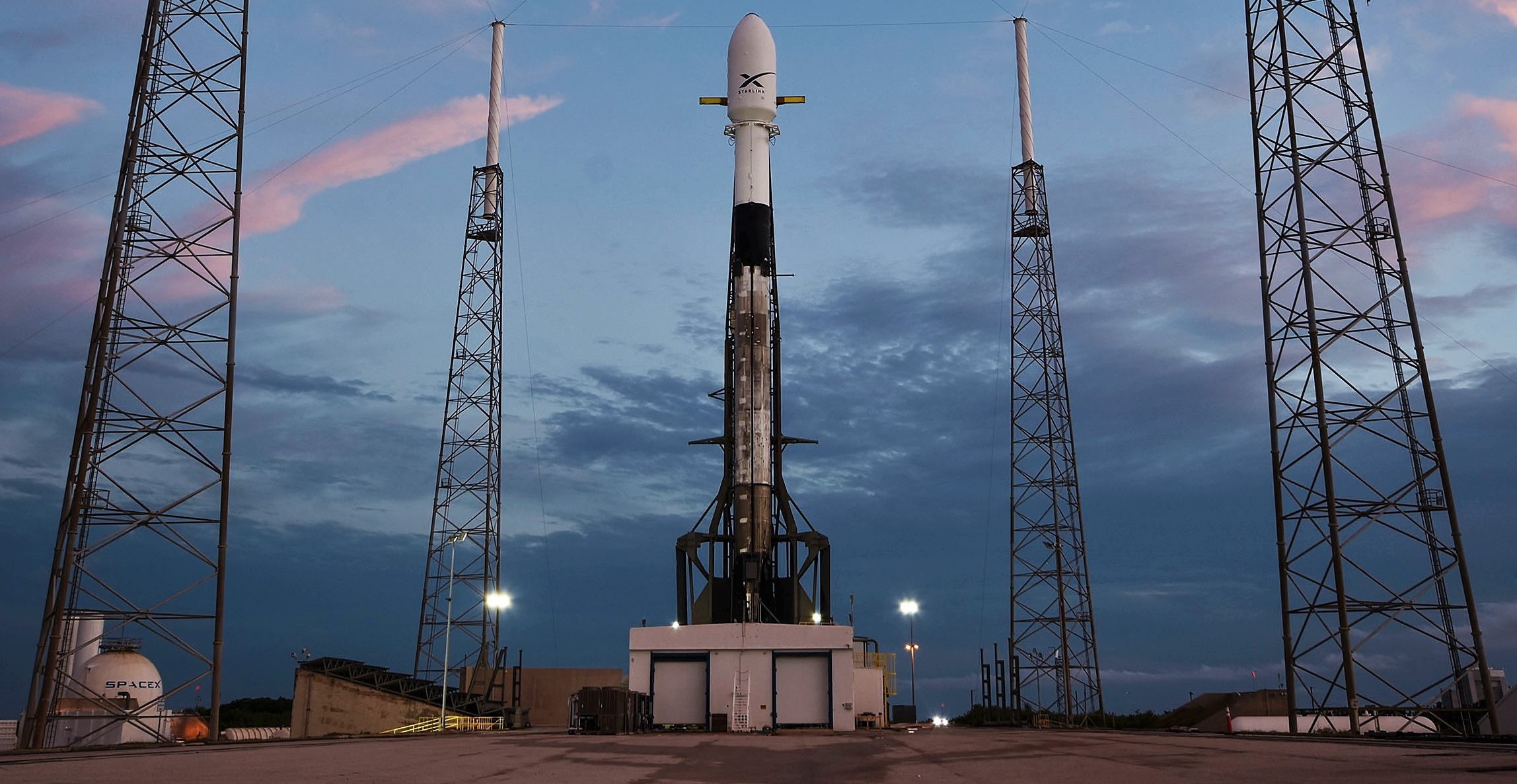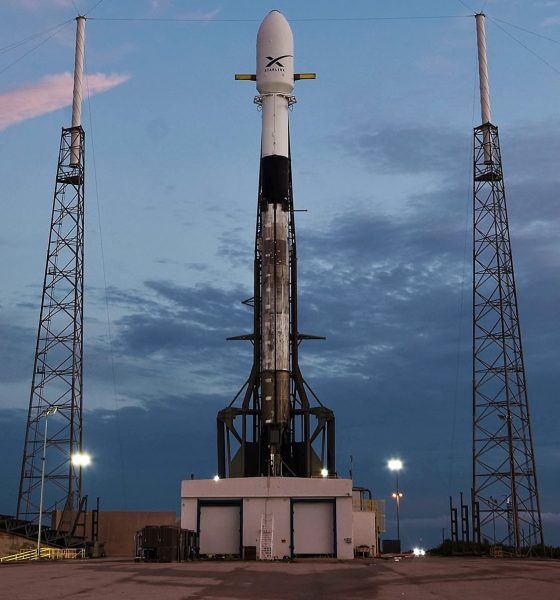

News
SpaceX reveals new Starlink satellite details 24 hours from launch
Less than 24 hours before SpaceX’s first dedicated Starlink mission is scheduled to lift off, the company revealed a handful of new details about the design of the 60 satellites cocooned inside Falcon 9’s fairing.
The Falcon 9 booster assigned to launch the Starlink v0.9 mission – B1049 – has already flown twice before in September 2018 and January 2019 and will likely take part in many additional launches prior to retirement. In support of B1049’s hopeful future, drone ship Of Course I Still Love You (OCISLY) arrived at its recovery location on May 13th, an impressive 620 km (385 mi) downrange relative to the launch’s low target orbit (440 km, 270 mi).
(Extra) smallsats
The combination of a distant booster recovery and a low target orbit can only mean one thing: the Starlink v0.9’s satellite payload is extremely heavy. As it just so happens, that is exactly the case per details included in SpaceX’s official press kit (PDF).
“With a flat-panel design featuring multiple high-throughput antennas and a single solar array, each Starlink satellite weighs approximately 227kg, allowing SpaceX to maximize mass production and take full advantage of Falcon 9’s launch capabilities. To adjust position on orbit, maintain intended altitude, and deorbit, Starlink satellites feature Hall thrusters powered by krypton. Designed and built upon the heritage of Dragon, each spacecraft is equipped with a Startracker navigation system that allows SpaceX to point the satellites with precision. Importantly, Starlink satellites are capable of tracking on-orbit debris and autonomously avoiding collisions. Additionally, 95 percent of all components of this design will quickly burn [up] in Earth’s atmosphere at the end of each satellite’s lifecycle—exceeding all current safety standards—with future iterative designs moving to complete disintegration.”

First and foremost, an individual satellite mass of around 227 kg (500 lb) is an impressive achievement, nearly halving the mass of the Tintin A/B prototypes SpaceX launched back in February 2018. For context, OneWeb’s essentially finalized satellite design weighs ~150 kg (330 lb) each and relies on a ~1050 kg (2310 lb) adapter capable of carrying ~30 satellites. Accounting for the adapter, that translates to ~180 kg (400 lb) per OneWeb satellite, around 25% lighter than Starlink v0.9 spacecraft.
However, assuming SpaceX has effectively achieved its desired per-satellite throughput of ~20 gigabits per second (Gbps), Starlink v0.9 could provide more than twice the performance of OneWeb’s satellites (PDF). These are still development satellites, however, and don’t carry the laser interlinks that will be standard on the all future spacecraft, likely increasing their mass an additional ~10%.

Despite the technical unknowns, it can be definitively concluded that SpaceX’s Starlink satellite form factor and packing efficiency are far ahead of anything comparable. Relative to the rockets it competes with, Falcon 9’s fairing is actually on the smaller side, but SpaceX has still managed to fit an incredible 60 fairly high-performance spacecraft inside it with plenty of room to spare. Additionally, SpaceX CEO Elon Musk says that these “flat-panel” Starlink satellites have no real adapter or dispenser, relying instead on their own structure to support the full stack. How each satellite will deploy on orbit is to be determined but it will likely be no less unorthodox than their integrated Borg cube-esque appearance.
That efficiency also means that the Starlink v0.9 is massive. At ~227 kg per satellite, the minimum mass is about 13,800 kg (30,400 lb), easily making it the heaviest payload SpaceX has ever attempted to launch. It’s difficult to exaggerate how ambitious a start this is for the company’s internal satellite development program – Starlink has gone from two rough prototypes to 60 satellites and one of the heaviest communications satellite payloads ever in less than a year and a half.
[Insert Kryptonite joke here]
Beyond their lightweight and space-efficient flat-panel design, the next most notable feature of SpaceX’s Starlink v0.9 satellites is their propulsion system of choice. Not only has SpaceX designed, built, tested, and qualified its own Hall Effect thrusters (HETs) for Starlink, but it has based those thrusters on krypton instead of industry-standard xenon gas propellant.
Based on a cursory review of academic and industry research into the technology, krypton-based Hall effect thrusters can beat xenon’s ISP (chemical efficiency) by 10-15% but produce 15-25% less thrust per a given power input. Additionally, krypton thrusters are also 15-25% less efficient than xenon thrusters, meaning that krypton generally requires significantly more power to match xenon’s thrust. However, the likeliest explanation for SpaceX’s choice of krypton over less exotic options is simple: firm prices are hard to come by for such rare noble gases, but krypton costs at least 5-10 times less than xenon for a given mass.

At the costs SpaceX is targeting ($500k-$1M per satellite), the price of propellant alone (say 25-50 kg) could be a major barrier to satellite affordability – 50 kg of xenon costs at least $100,000, while 50 kg of krypton is more like $10,000-25,000. The more propellant each Starlink satellite can carry, the longer each spacecraft can safely operate, another way to lower the lifetime cost of a satellite megaconstellation.
SpaceX’s dedicated Starlink launch debut is set to lift off no earlier than 10:30pm EDT (02:30 UTC), May 15th. This is not a webcast you want to miss!
Check out Teslarati’s Marketplace! We offer Tesla accessories, including for the Tesla Cybertruck and Tesla Model 3.

News
Elon Musk’s Grokipedia surges to 5.6M articles, almost 79% of English Wikipedia
The explosive growth marks a major milestone for the AI-powered online encyclopedia, which was launched by Elon Musk’s xAI just months ago.

Elon Musk’s Grokipedia has grown to an impressive 5,615,201 articles as of today, closing in on 79% of the English Wikipedia’s current total of 7,119,376 articles.
The explosive growth marks a major milestone for the AI-powered online encyclopedia, which was launched by Elon Musk’s xAI just months ago. Needless to say, it would only be a matter of time before Grokipedia exceeds English Wikipedia in sheer volume.
Grokipedia’s rapid growth
xAI’s vision for Grokipedia emphasizes neutrality, while Grok’s reasoning capabilities allow for fast drafting and fact-checking. When Elon Musk announced the initiative in late September 2025, he noted that Grokipedia would be an improvement to Wikipedia because it would be designed to avoid bias.
At the time, Musk noted that Grokipedia “is a necessary step towards the xAI goal of understanding the Universe.”
Grokipedia was launched in late October, and while xAI was careful to list it only as Version 0.1 at the time, the online encyclopedia immediately earned praise. Wikipedia co-founder Larry Sanger highlighted the project’s innovative approach, noting how it leverages AI to fill knowledge gaps and enable rapid updates. Netizens also observed how Grokipedia tends to present articles in a more objective manner compared to Wikipedia, which is edited by humans.
Elon Musk’s ambitious plans
With 5,615,201 total articles, Grokipedia has now grown to almost 79% of English Wikipedia’s article base. This is incredibly quick, though Grokipedia remains text-only for now. xAI, for its part, has now updated the online encyclopedia’s iteration to v0.2.
Elon Musk has shared bold ideas for Grokipedia, including sending a record of the entire knowledge base to space as part of xAI’s mission to preserve and expand human understanding. At some point, Musk stated that Grokipedia will be renamed to Encyclopedia Galactica, and it will be sent to the cosmos.
“When Grokipedia is good enough (long way to go), we will change the name to Encyclopedia Galactica. It will be an open source distillation of all knowledge, including audio, images and video. Join xAI to help build the sci-fi version of the Library of Alexandria!” Musk wrote, adding in a later post that “Copies will be etched in stone and sent to the Moon, Mars and beyond. This time, it will not be lost.”
News
Tesla Model 3 becomes Netherlands’ best-selling used EV in 2025
More than one in ten second-hand electric cars sold in the country last year was a Tesla Model 3.

The Tesla Model 3 became the most popular used electric car in the Netherlands in 2025, cementing its dominance well beyond the country’s new-car market.
After years at the top of Dutch EV sales charts, the Model 3 now leads the country’s second-hand EV market by a wide margin, as record used-car purchases pushed electric vehicles further into the mainstream.
Model 3 takes a commanding lead
The Netherlands recorded more than 2.1 million used car sales last year, the highest level on record. Of those, roughly 4.8%, or about 102,000 vehicles, were electric. Within that growing segment, the Tesla Model 3 stood far ahead of its competitors.
In 2025 alone, 11,338 used Model 3s changed hands, giving the car an 11.1% share of the country’s entire used EV market. That means more than one in ten second-hand electric cars sold in the country last year was a Tesla Model 3, Auto Week Netherlands reported. The scale of its lead is striking: the gap between the Model 3 and the second-place finisher, the Volkswagen ID3, is more than 6,700 vehicles.
Rivals trail as residual values shape rankings
The Volkswagen ID.3 ranked a distant second, with 4,595 used units sold and a 4.5% market share. Close behind was the Audi e-tron, which placed third with 4,236 registrations. As noted by Auto Week Netherlands, relatively low residual values likely boosted the e-tron’s appeal in the used market, despite its higher original price.
Other strong performers included the Kia Niro, the Tesla Model Y, and the Hyundai Kona, highlighting continued demand for compact and midsize electric vehicles with proven range and reliability. No other model, however, came close to matching the Model 3’s scale or market presence.
News
Tesla Model Y Standard Long Range RWD launches in Europe
The update was announced by Tesla Europe & Middle East in a post on its official social media account on X.

Tesla has expanded the Model Y lineup in Europe with the introduction of the Standard Long Range RWD variant, which offers an impressive 657 km of WLTP range.
The update was announced by Tesla Europe & Middle East in a post on its official social media account on X.
Model Y Standard Long Range RWD Details
Tesla Europe & Middle East highlighted some of the Model Y Standard Long Range RWD’s most notable specs, from its 657 km of WLTP range to its 2,118 liters of cargo volume. More importantly, Tesla also noted that the newly released variant only consumes 12.7 kWh per 100 km, making it the most efficient Model Y to date.
The Model Y Standard provides a lower entry point for consumers who wish to enter the Tesla ecosystem at the lowest possible price. While the Model 3 Standard is still more affordable, some consumers might prefer the Model Y Standard due to its larger size and crossover form factor. The fact that the Model Y Standard is equipped with Tesla’s AI4 computer also makes it ready for FSD’s eventual rollout to the region.
Top Gear’s Model Y Standard review
Top Gear‘s recent review of the Tesla Model Y Standard highlighted some of the vehicle’s most notable features, such as its impressive real-world range, stellar infotainment system, and spacious interior. As per the publication, the Model Y Standard still retains a lot of what makes Tesla’s vehicles well-rounded, even if it’s been equipped with a simplified interior.
Top Gear compared the Model Y Standard to its rivals in the same segment. “The introduction of the Standard trim brings the Model Y in line with the entry price of most of its closest competition. In fact, it’s actually cheaper than a Peugeot e-3008 and costs £5k less than an entry-level Audi Q4 e-tron. It also makes the Ford Mustang Mach-E look a little short with its higher entry price and worse range,” the publication wrote.








